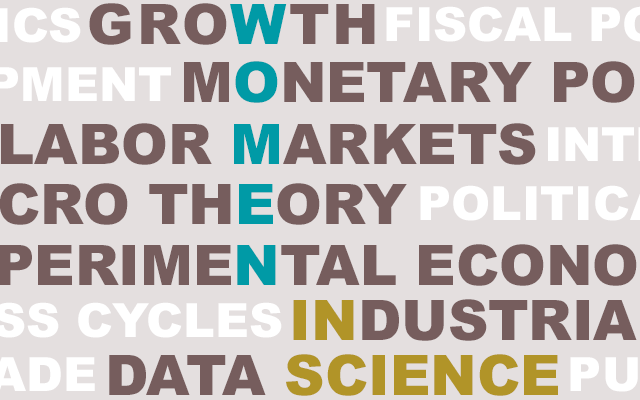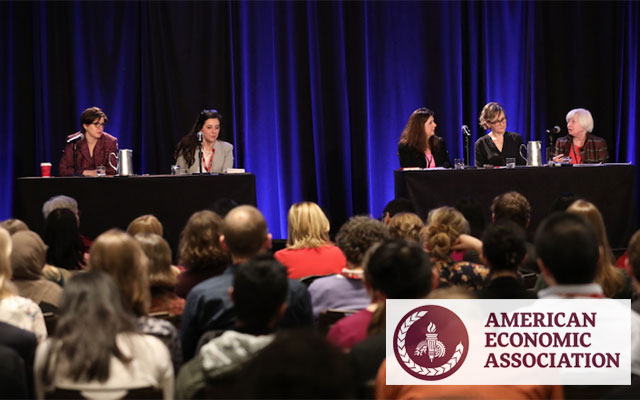community
#WomenInScience: Economics by women at the BSE

February 11 is International Women in Science Day. In honor of the occasion, let's take a look at the many ways that female economists are contributing to the BSE as leaders, professors, and researchers:
Leadership roles for women at the BSE
Both executive leadership positions are held by women
- Paulina Beato, Chair of the Board of Trustees
- Teresa Garcia-Milà, Director
Directors of 3 out of 7 Master's programs are women
- Rosa Ferrer, Director of the Master's in Competition and Market Regulation
- Ada Ferrer-i-Carbonell, Deputy Director of Academic Programs and Director of the Master's in Economics of Public Policy
- Marta Reynal-Querol, Director and Eulàlia Nualart, Deputy Director of the Master's in Economics
Research recognition for female economists
European Research Council (ERC) Grants for female BSE Affiliated Professors
- 2018: Maria Petrova, "The Rise and Fall of Populism and Extremism"
- 2017: Libertad González, "The Causal Effect of Public Policy and Income on Child Health and Human Capital"
- 2014: Marta Reynal-Querol, "Historical Roots of Conflict: From Prehistory to the Colonization Experience"
- 2013: Barbara Rossi, "New Methods and Applications for Forecast Evaluation"
- 2007: Marta Reynal-Querol, "Understanding and Preventing Conflicts"
"La Caixa Grants" on Socioeconomic Well-being awarded to women
- 2018: Laura Mayoral, "Inequality, Political Instability and Long-Term Development" (with J.M. Esteban)
- 2017: Libertad González, "The Causal Effect of Early Interventions on Child Health and Cognitive Development"
Publications by female Affiliated Professors in 2018 Recognition Program
- Enriqueta Aragonès, "Imperfectly Informed Voters and Strategic Extremism" (with D. Xefteris). International Economic Review, 58(2), 439–471.
- Ana Rute Cardoso, three publications including "Bargaining, Sorting, and the Gender Wage Gap: Quantifying the Impact of Firms on the Relative Pay of Women" (with D. Card and P. Kline). Quarterly Journal of Economics, 131(2), 633–686.
- Rosa Ferrer, "Gender gaps in performance: Evidence from young lawyers" (with G. Azmat). Journal of Political Economy, 125(5), 1306–1355.
- Inés Macho-Stadler, two publications including "Private versus social incentives for pharmaceutical innovation" (with P. González and D. Pérez-Castrillo). Journal of Health Economics, 50, 286-297.
- Laura Mayoral, "Uncertainty, model selection, and the PPP puzzle" (with M.D. Gadea). Oxford Economic Papers, 67(3), 614–633.
- Maria Petrova, "Radio and the Rise of The Nazis in Prewar Germany" (with M. Adena, R. Enikolopov, V. Santarosa, and E. Zhuravskaya). Quarterly Journal of Economics, 130(4), 1885–1939.
- Barbara Rossi, four publications including "Rolling window selection for out-of-sample forecasting with time-varying parameters" (with A. Inoue and L. Jin). Journal of Econometrics, 196(1), 55–67.
Outstanding work by women in Economics PhD programs
- 2019: Ana Costa-Ramón and Ana Rodríguez-González nominated for the "Vanguard of Science" Award
- 2017: Federica Daniele wins Job Market Best Paper Award from Unicredit & Universities
More opportunities for women at the BSE
We celebrate the achievements of our female professors, researchers, and students, and at the same time, we look forward to improving participation by women across all areas of our community. The following indicators for Academic Year 2018-19 highlight some of these areas. The indicators depend on several factors, such as hiring decisions by the academic units, research proposal submissions by female researchers, and applications to academic programs by women:
- BSE Affiliated Professors (19% women)
- BSE Research Professors (14% women)
- BSE Scientific Council (13% women)
- BSE Seed Grants (25% awarded to proposals by female economists)
- Enrollment of women in GPEFM and IDEA PhD programs (26% women)
- Enrollment of women in BSE Master's programs (36% women)
Robert Sgariglia (ITFD '18, now a Data Analyst for Bloomberg) wrote about some of the challenges women face in all the sciences in a post on the BSE Voice for Women in Science Day last year. In the Economics profession, there are many challenges specific to women both in academia and beyond. For some insights on this topic by leading female economists, see the webcast How Can Economics Solve Its Gender Problem? from the American Economic Association.
How Can Economics Solve Its Gender Problem?
Presiding: Betsey Stevenson, University of Michigan
Janet Yellen, Brookings Institution
Susan Athey, Stanford University
Sebnem Kalemli-Özcan, University of Maryland
Marianne Bertrand, University of Chicago
Hat tip to Libertad González for sharing this video and some personal insights on Nada Es Gratis (in Spanish).

